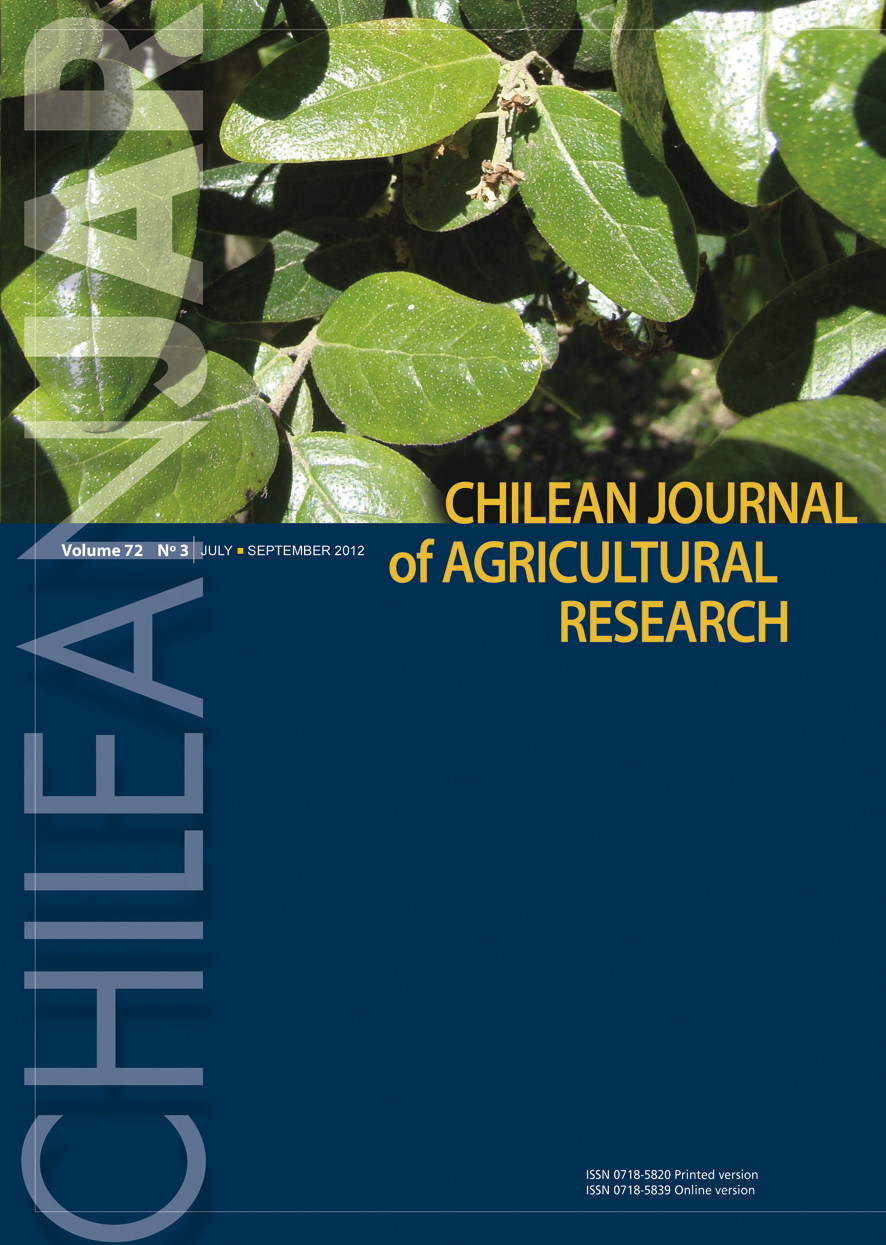
|
Chilean Journal of Agricultural Research
Instituto de Investigaciones Agropecuarias, INIA
ISSN: 0718-5820
EISSN: 0718-5820
Vol. 70, No. 3, 2010, pp. 372-380
|
 Bioline Code: cj10041
Bioline Code: cj10041
Full paper language: English
Document type: Research Article
Document available free of charge
|
|
|
Chilean Journal of Agricultural Research, Vol. 70, No. 3, 2010, pp. 372-380
| en |
Evaluation of the resistance of transgenic c5 plum (Prunus domestica L.) against four Chilean plum pox virus isolates through micro-grafting
Wong, Wendy; Barba, Paola; Álvarez, Catalina; Castro, Álvaro; Acuña, Manuel; Zamora, Pablo; Rosales, Marlene; Dell'Orto, Paola; Moynihan, Michael R.; Scorza, Ralph & Prieto, Humberto
Abstract
The transgenic plum (Prunus domestica L.) C5, in which the coat protein (CP) gene of the Plum pox virus (PPV) is inserted, represents a unique example of the use of genetic engineering for fruit crop improvement in Prunus spp. Field trials in Poland, Romania, and Spain have demonstrated resistance of C5 to several D and M strain PPV isolates. In Chile, the quarantine regulations for PPV and for genetically modified (GM) plants require that the testing of C5 for resistance to Chilean PPV isolates be done under controlled isolated conditions. To carry out these tests C5 shoots were multiplied
in vitro
and micro-grafted onto four Adesoto101 (Prunus insititia L.) rootstock populations that had been previously infected each with one of four Chilean PPV-Ds. Tests were carried out under controlled conditions in a biosafety greenhouse. Symptoms appearance, virus detection, and viral mRNA levels for the cylindrical inclusion (CI) and CP genes were determined during three consecutive growing seasons. Complete resistance to all PPV isolates was demonstrated during the first 2 yr in all of the C5 plants. In the third season, four of 10 C5 plants showed mild symptoms on leaves close to the graft union and low but detectable CI mRNA levels in the C5 scions. These results support the effectiveness of using of micro-grafting on P. insititia for PPV resistance studies, especially in the limited space of a quarantine facility; whereas resistance levels in C5 after 3 yr indicate the importance of long term and field scale evaluations.
Keywords
C5, Plum pox virus, Chilean isolates, Prunus domestica, Prunus insititia, micro-grafting
|
| |
| es |
Evaluación de la resistencia de ciruelo transgénico C5 (Prunus domestica L.) contra cuatro aislamientos chilenos del Virus pox del ciruelo a través de microinjertos.
Wong, Wendy; Barba, Paola; Álvarez, Catalina; Castro, Álvaro; Acuña, Manuel; Zamora, Pablo; Rosales, Marlene; Dell'Orto, Paola; Moynihan, Michael R.; Scorza, Ralph & Prieto, Humberto
Resumen
El ciruelo (Prunus domestica L.) transgénico C5, que posee inserto el gen de la proteína de cubierta (CP) del Plum pox virus (PPV), es un ejemplo excepcional del uso de ingeniería genética para el mejoramiento de Prunus spp. Pruebas de campo realizadas en Polonia, Rumania y España han demostrado su resistencia a distintos aislamientos de PPV cepas D y M. En Chile, dadas las regulaciones cuarentenarias para PPV y para plantas genéticamente modificadas, los análisis de resistencia de C5 deben ser ejecutados bajo condiciones de confinamiento. Para realizar estas pruebas, se multiplicaron in vitro brotes de C5 y se microinjertaron en cuatro grupos de ‘Adesoto 101’ (Prunus insititia L.) previamente infectados con cuatro aislamientos de PPV-D chilenos ya caracterizados. Todos los ensayos se realizaron bajo condiciones controladas en invernadero de bioseguridad. Durante tres temporadas se analizó sintomatología, presencia de virus y niveles de mARN viral para los genes de la proteína de inclusión cilíndrica (CI) y CP. Durante los primeros 2 años se encontró una resistencia completa a todos los aislamientos en todos los injertos. Al tercer año, cuatro de 10 injertos C5 mostraron síntomas leves en hojas cercanas al sitio de injertación y un nivel bajo, pero detectable, de mARN de CI. Estos resultados avalan la utilidad de la microinjertación en P. insititia para estudios de resistencia a PPV, especialmente en un recinto cuarentenario, mientras que los niveles de resistencia mostrados por C5 luego de 3 años indican la necesidad de evaluaciones prolongadas y preferentemente en campo .
Palabras-clave
C5, Plum pox virus, aislamientos chilenos, Prunus domestica, Prunus insititia, microinjertación
|
| |
© Copyright 2010 Chilean Journal of Agricultural Research.
Alternative site location: http://www.inia.cl
|
|
